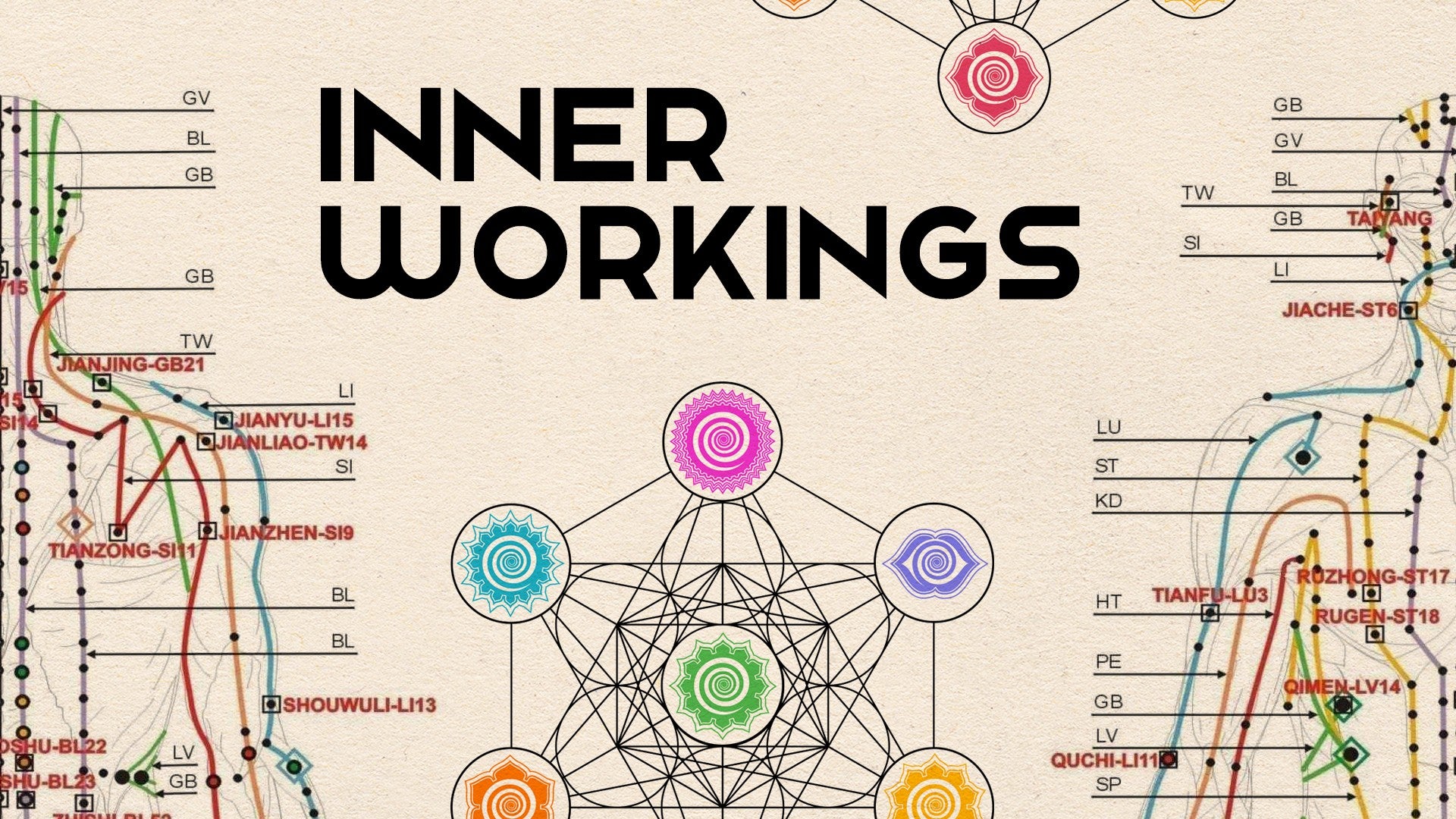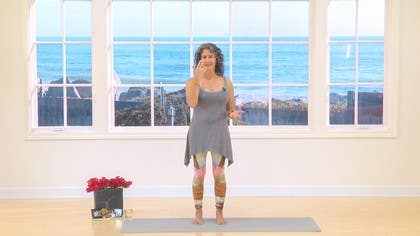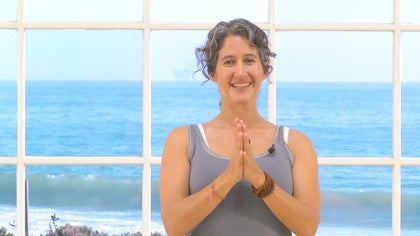Description
About This Video
Transcript
Read Full Transcript
(waves lapping) Welcome back. So now I'll try to put some of these small, short, little lessons that we've done together in how you might start to approach some of your postures. So to review, we've explored the movement of the tailbone and the sacrum, and how that interrelates with the rotation of the hips. And then we've tuned into how that works, okay, with the subtler channels, what the yogis call the nadis. Okay, we've done a little bit of opening in the shoulders and the neck, and a little bit of tuning to the quality of suchness available when your hands are sensitive to it.
So we're gonna see if we can put some of these together towards the exploration of Parsvottanasana, which sometimes gets translated as pyramid pose. You can really call it whatever you want. So what we'll do is we'll meet at the front of the mat. Okay, so as you come to the front of the mat, you'll find your way into Tadasana, and what I'm gonna suggest, I'm gonna say this afternoon. I'm not exactly sure when you're practicing, but this afternoon seems correct.
What I'm gonna suggest this afternoon is that we bring our feet a little bit closer. So balls of the big toes maybe touching, maybe just touching. Lift up through the toes a little bit. Get your inner arches happening. And then allow the toes to spread back down on the earth.
And now to really put some of these lessons together. Big deliberate inhale and exhale. Let it happen and soften the knees a little bit. Let your sit bones relax. You're not tucking your tailbone, but you're relaxing.
Remember when we were relaxing the pelvic floor? Same idea. And then the play here once you feel grounded, so remember how to relax in your belly, soft in the floor of the pelvis. Your jaw's gonna press enough to tune the instrument of the heart, so that quality of Dhyana, wide open awareness. And let the quality of your mind be open and light.
Okay, now alignment is a cooperative affair. And so as you tune into your alignment, you'll know that your there, for lack of a better expression, you'll know that you're in that cooperation when it's not so much work. Okay, so now again, do you remember how to tune into the channels of your nostrils? So can you just now, can you feel the inner channels? Just bring your mind to the inner channels.
And see if that helps you lift the inner line of yourself. Tune into the outer channels. Okay, nice. See how it feels to tune into the back channels. And you're just becoming more and more sensitive to small details, because if it was about achievement of the postures, right, then we would have temples to our gymnasts.
Okay, the posture is a place of exploration. So I'm gonna start with my hands on my waist. So again, we're finding Parsvottanasana. I'm gonna keep my left foot forward. I'm gonna set my right foot back.
Now as we've explored in our posing show and in other shows, how far your feet are apart will change what you're working on. So the further your feet are apart, okay, the more difficult the balance will be. The narrower your feet are, meaning the more my heel is in line with my inner arch, the more difficult the balance will be. The shorter, squattier stance, or shorter, wider stance, to use a better word, will be more stable. Okay, so you gotta tune this stance so it feels still somewhat simple for you.
So I'm gonna choose my heel basically in line with my arch. I'm gonna bring my hands to the waist. Now here's the play. Start to become aware of your back foot. So for me that's the right foot.
Start to become aware of your back foot and as you press into your back foot, can you become aware, just like we did at the wall, just like we where doing standing, can you become aware of the feeling tone in the right nostril? And can you tune the alignment of that foot and the alignment of that hip so that you feel more full and open through the right nostril? Yeah. So for me it'll help if I, I'm actually gonna choose to widen my stance. I can see that I need to go a little wider now that I'm really in there.
And if I kind of press into the outer edge of my foot and lift up through the inner arch, that's the alignment. As I let my hip internally rotate, that's the alignment that allows my nostril to feel the most open. Okay? And now let's do the same thing on the front foot. So same idea.
You're gonna tune into where your front foot is. For me that's my left foot. For you it might be your right. I'm gonna tune into the alignment on my front foot, and I'm tuning through that foot up through that hip, up through this left nostril. And the play here is what am I doing in that foot, that hip, to feel more free in the breath?
So that instead of following external instructions from a well-intentioned friend, I'm finding the alignment that allows me to feel more open. And so for me in this particular one, if I give a little rooting through the ball of the big toe and allow for this hip to just so tenderly externally rotate back, do you remember how to do that? And then I feel a lift up through my heart. That's what works. Now here's the thing.
When you're working this slow you've already been in this posture way longer than any Vinyasa class. And so you start to get into these more subtle, quiet details. So for some of you it's gonna make most sense to explore this with the hands on the waist because it's the not demanding in your shoulders, not demanding in your wrist. And since we did do that earlier shoulder opening, we'll just see. If you let your arms come out to the side and you rotate your shoulders forward.
A nice thing to do is just to bring, since my left foot is forward, I'm gonna bring my left hand in my right palm now. I'm not sure if you can see that so I'm just gonna turn a little bit so you can see. So I've just put my left hand in my right palm. And so for some of you this will be the perfect spot. Okay?
What some of you will do, and I'm gonna sort of show in this kiddywampus position just so that it has more chance of being clear. What some of you will do is you'll bring the fingertips to each other and you'll just start to shnoogle your hands up the back into what we call reverse prayer. Now if you did that and you wish you hadn't, go back to here. Okay, if you did that and it felt good, then you let your shoulders row back and down and you actually send your elbows forward. Okay, realign, press into the feet.
Let the nostrils open. And here's the really torturous part because we're gonna go so slow. You've probably caught on about that, about me. (laughing) Root, inhale, and then you're just gonna fold forward a little bit and you're gonna pause. And what you're pausing is to just assess if these channels are still open.
What do I need to do in this left hip? Do I need to roll it back a little bit? Do I need to lift my heart a little bit? What do I need to do in my right foot? Remember how to be gooey in the back of the neck?
And so this is a spot to stay and just listen, listen, listen. So some of you are gonna stay right here and if all of a sudden you're like wow, I really wish I could bend my front left knee, then you let it bend and you see what that does in your breath. And then maybe you let it straighten again. But rarely, like very few people actually does it feel good to have this leg straight. Root, bloom.
Okay, if appropriate, you drop in a little bit deeper, and then you pause again. You pause again and you check in. You're like, how am I doing? And the way you find out how you're doing is how does it feel in your breath? How does it really actually feel in your breath?
What's goin' on? Okay, you might stay right here. Some of you, it's appropriate to deepen, but the play is the temptation is so great to complete the posture in the way that it looks. And so it requires this vigilance, vigilance to stay where you are and actually notice what's happening. Now because of how I'm designed, like I'm designed to fold forward.
Like I was born to fold forward. So it just works out for me that it actually feels quite good. Okay, eventually you're gonna root through the feet and you're gonna inhale, and you're gonna roll back up. And then you're gonna release the hands. Let that front knee bend and you'll step to the front of the mat.
And you just pause. And the play is just notice, like notice the quality of mind from working like this. Okay, like notice the quality of how you feel. Like right, it brings us back to what's the purpose of yoga. Okay, we'll find the other side together.
Pretty sure, yes. (laughing) It's amazing that I can get lost between two sides. Okay, right foot's forward, left foot's back. Now this side is different for me and it'll be different for you. Okay, so you'll notice I've already chosen, I kind of know a little wider stance today, a little like shorter stance is gonna be better for me.
Generally the wider stance works more stability, grounding. Generally the narrower, longer works more accuracy, balance. So it's the same idea. And those of you that are yoga teachers, this is how you start to find the alignment instructions that are true for you. Okay, and what I mean by that is so that you really know the alignment instruction deep in your own bones, deep in your own breath, so that as you realize, okay, as you discover that by rooting through the outer pinky pad of the back left foot and by lifting up through the inner arch and by internally rotating your hip and letting your heart brighten, as you realize that truly opens the channels on that side for you in your breath.
Then those instructions, those cues, those translations become true because they resonate from a deep place in you. Okay, like often when we start teaching, we just parrot. Okay, so I'm finding that rooting and rolling and lifting, and then I'm finding that actually if I let my sit bones drop a little bit, that helps. Even though sometimes the posture gets taut with the pelvis rolling forward, right now dropping my sit bones is feeling much nicer. And then in this front foot I'm gonna widen a little bit and as I root and open and feel this right hip externally rotate back and I feel that inner line and I feel the heart, then it's like phoo, solid, stable, and quiet.
Okay, and true. Yeah. Okay, and I'm gonna show this time, I'm gonna show hands on the waist. Like if I continually suggest that this is okay, but I continually show something more difficult, then I'm a liar. So hands on the waist.
Some of you are gonna find the reverse prayer. Some of you are gonna find that right hand resting in your left. So you choose what works. Okay, root, bloom, I'm tuned into my nostrils and then as I tune into those, okay, then when I'm ready, when I get that internal light, I'll start to fold forward, and I'll just pause here rolling this hip back, lengthening through this heart, gooey in the back of the neck. And as you root and you bloom, you're practicing a quality of patience, inner listening, time.
And right now, today, that if I engage up through this thigh and this front right leg, it helps. And as I kind of press back through that back leg it's helping. This might be the spot. You might drop in a little deeper. And you're watching the barometer zone of your face.
We've explored this in season one and season two a little bit. Like if this is gripping, the face is gripping, it's clear. Now I've been showing hands on the waist or hands behind, but you might have the particular body that letting your hands come to the earth just makes more sense, so then you do it. You might have a body where it makes more sense to let this front knee bend. Then you do it.
When you do that you take that hamstring out of the equation, you can get more rotation in your hip. Okay, some of you might be here. Some of you might choose to fold forward a little bit. But the play is to continually develop your capacity to be in relationship. That's really the whole point, because you are in relationship.
We're in relationship. It's just too much for us most of the time. Okay. Pow. When it feels like you've been there long enough and even, you'll bring your hands back onto your waist and you'll let yourself come all the way back up.
And then you'll let yourself step forward. Okay, now pause at the front of your mat. Tadasana. Shoulders roll back and down. Big deliberate inhale.
Exhale everything. I really like like you've tuned both of these channels, right? You've been tuning the sides of the subtle body, and so what usually will start to reveal herself is the central channel that the yogis call the Shushumna. And as you relax the floor of the pelvis, as you relax your low belly, sometimes you'll catch her from the tailbone region up through the base of the skull, up through the top of the head. The Shushumna, which the yogis, one of the definitions is the gracious channel.
Nice. And then most likely by now you're wishing you could fold forward, so yes, Uttanasana. And what sometimes feels good is Malasana squat. So just like coming down into a squat, 'cause you've been strengthening your hips, so a little bit of opening up your hips can feel good. And remember how I was saying I was born to forward fold?
I was also born to squat. So your squat may or may not look like this. Awwww. (laughing) Okay, Uttanasana. Draw the sit bones up, toe heel the feet back towards each other.
Bend the knees, chin into the chest, and slow, let yourself start to roll back up. Belly hard, throat and face. Nice. So the play, right? The play that we're working on here is like how to be in the postures for a more subtle place.
In the beginning sometimes it's helpful when somebody's telling us exactly what to do, where to put our foot, where to put our hand, where to do our heart. That can be helpful in the beginning. But you've been doing this awhile now and the truth is you have access. You have access to the same source from where all these alignments have come. You have access to the source from where all these teachings come.
And so the play is you start to tune into the subtler currents, that the hope is that you'll start to discover the alignment points that are perfect for you and only you, and will continually change. This is one of the most difficult things. Just when we find what's perfect, it changes. (laughing) So try this with some of your other favorite postures. See what you find out.
Let us know. Namaste.
Inner Workings: From the Visible to the Invisible
Comments
You need to be a subscriber to post a comment.
Please Log In or Create an Account to start your free trial.











